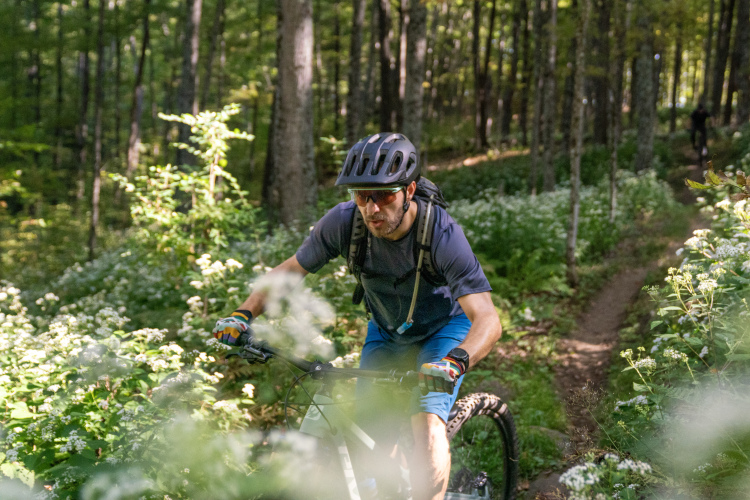

About a year ago I shared what I did to become a better climber during the 2022-23 winter riding season. While the article focused on sharing what I did to become a better climber, I didn’t start the challenge with any sort of plan.
Ultimately, I was successful. I finally reached the top as winter rolled into spring—no dabs. However, I never had a plan going into the challenge. I either made it up on the fly or later reflected on what I just happened to do that seemed to work.
I wondered how knowing the proper techniques and skills would have aided me. Honestly, I wondered what the proper techniques and skills were. Luckily, Ryan Leech was happy to help.
Ride-Learn-Connect
Leech began his professional career as a teenager, quickly becoming one of the most prominent trials riders in the world. If his name is unfamiliar to you, search it up along with “Kranked” on YouTube and enjoy some quality late ‘90s-early 2000s mountain biking videos.
Coaching always seemed to be a part of Leech’s professional mountain biking career. “Throughout my entire career, I actually had been coaching mountain bike skills, even as a teenager. That’s when I got my first certification as a coach,” Leech told me.
Many years of leading clinics and retreats gave Leech a solid foundation for eventually pursuing coaching full-time. This would lead to the opening of Ride-Learn-Connect—RLC Online MTB Coaching, where members can sign up for a variety of courses and work on progression at their own pace.
Leech is a pioneer of sorts. Eight years ago, he was among the first to offer fully online mountain bike instruction. Our meeting must have been serendipitous, as Leech is getting ready to add a 23rd course to his online program—a course on technical climbing.
Needless to say, many of my questions were fresh on his mind.
Where should my butt be?
The first thing Leech acknowledged was how difficult it is to speak about how to climb—or any mountain bike skill—in general terms. Each climb will be a bit different, and each person will be different in terms of skill and fitness levels. But it did seem like some common threads are consistent across the board.
A common question that many have is if we should be seated or standing up, powerfully attacking the climb. “In general, you’re going to have the best traction when your butt is in the saddle,” Leech said. Body weight over the rear wheel is the main thing that keeps tire treads digging into the trail and not slipping.
When we need power or our weight over the front a bit more, we may be prematurely standing up out of the saddle. “There’s not a static position with your butt on the saddle; you can slide it back, you can slide it forward,” Leech explained. Depending on the trail’s technicality, you may get away with shifting your weight on the saddle rather than standing, providing much better traction.
Sliding forward in your saddle—and steep climbs in general—tends to have you bending your arms and moving your body toward the bars. While this is a natural tendency, you want to ensure the forward lean isn’t too drastic. Bending your elbows and leaning too far forward won’t allow for proper bike maneuvering—if any at all.
Instead, keep your elbows at a natural bend in a relaxed position. It is easy to think that the only climbing component is our legs, but our arms must also work, lifting and pushing the bike over technical features.

Maybe it’s momentum
Typically, as climbs get more challenging, they become steeper and more technical. And while we may need to get out of the saddle to lift the front of the bike over an obstacle, Leech recommends attacking in a different way. Rather than getting out of the saddle and trying to lift and pedal the bike up something like a rock shelf, he encourages his students to remain seated and put the power down before the obstacle, standing just before approaching it. Try creating the speed and momentum needed to pop up the obstacle so the only time you’re out of the saddle is when you maneuver the bike up the obstacle.
But it doesn’t end with creating momentum before the obstacle. Leech also teaches his students to generate speed after the obstacle by moving the bike forward. He broke it down by explaining that we need to be thinking that we are not only going to get our bike up an obstacle but over an obstacle, too. Extending the bike forward to get over the obstacle will help continue that momentum.
While doing our best to carry momentum into an obstacle, Leech said it doesn’t hurt to drop your saddle a bit. “I’m going to drop the saddle an inch or two because I need the ability to add a little bit more body language,” Leech said. But when you don’t need that space, get it up to your full riding height because you need the efficiency.”
Regardless of being seated or standing while climbing, Leech also emphasized a smooth, consistent cadence as an essential factor in providing traction. Pedaling during steep, technical climbs can often feel more like survival. Leech highly recommends being intentional with your cadence until it becomes second nature.

Where do I look?
Whether in the saddle or standing to climb an obstacle will depend heavily on our line choice. You will hear hard and fast rules about looking ahead “X” bike lengths in mountain biking. Due to the generally slower climbing speed, Leech isn’t so concerned with how many bike lengths ahead you focus.
Rather than focusing on bike lengths, be more concerned about line choice. Here, Leech explained that the path of least resistance isn’t always what it seems.
For example, a rock ledge might have a steeper, more jagged line on the right and a smoother, more gradual line to the left. However, if loose gravel covers the left line, what appears to be the more “difficult” line might be significantly easier.
Easy gear with a fast cadence or hard gear with slow cadence?
Each camp has its argument, and both sides make good points. For Leech, he recommends that if you’re in doubt, choose an easier gear.
“If you’re in a harder gear, slower cadence, as soon as you need that easier gear, it will take longer to make that shift,” Leech explained. “And you might not be able to make that shift because the load on the drivetrain is just too great.”
Being in that easier gear will also allow you to keep your desired cadence as the climb gets steeper and more technical.
However, Leech acknowledges that people can often camp in an easy gear for too long. Especially with big, 52-tooth modern-day drivetrains, larger, easier cogs may not generate the power needed to make it up an obstacle. This back-and-forth difficulty between cogs is an excellent reason to know the trail and anticipate what is coming ahead. Just like you may need to find places to gain momentum before your butt leaves the saddle, you may need to shift up to gain momentum for a problematic section.
Being ready and knowing how to change gears on a climb is essential. Leech often sees riders stuck in the mindset of “climb equals easiest gear.” We need to shift between gears to maintain cadence and build momentum. “I think a sign of a more skillful rider is one that shifts more frequently,” Leech said.
This can be tricky, but similar to learning how to drive a stick shift, and over time you’ll find your spots to shift. If not, consider investing in the SRAM T-Type drivetrain which makes it easier to shift under load.
Blame it on the bike?
Sloppy hubs, old drivetrains, bad geometry—whatever the excuse, our bikes are easy targets when we struggle during the climb. Unfortunately for our egos, Leech doesn’t subscribe to the “blame it on the bike” mentality.
That said, too much suspension can get you into trouble. Leech says to flip that climb switch for long-travel trail rides or enduro rides. “If you’re on like a big squishy long-travel bike, you’re adding an extra challenge. The bike will be squished with your weight on the saddle, almost as if it makes the climb steeper.” Firming up or locking the suspension out will help with efficiency and cadence.
Modern short-travel trail bikes are built so well that the climb switch is much less necessary and may hinder your climbing. Our rear suspension also provides traction, keeping our butts in the saddle while carrying momentum with a smooth cadence.
Leech also mentioned that if you frequently reach for your climb switch, you may need to ensure your suspension is set up correctly. Proper suspension settings will help with climbing traction and efficiency and provide a better all-around ride.
Perhaps the most crucial factor…
More than the bike we are on, how efficiently we pedal, or the position of our saddle, Leech shared that the most hindering factor to becoming a proficient climber is ourselves. The vast majority of the time, it is our fitness and our mindset that holds us back.
Challenging, steep climbs require a certain level of fitness. They also require different types of fitness: endurance to keep the wheels spinning for the duration and power for the technical sections. Leech recommends focusing your training—both on and off the bike—on climbing endurance and power.
Despite having the fitness and skills, it could ultimately be our own doubt that has us putting a foot down. “The only way to improve as a technical climber is never to give up ahead of time,” Leech said. “Always push to your absolute skill and fitness limits. Your fitness is tested, your skills are tested, and then you get to the top, and it’s the best feeling ever.”











2 Comments
May 4, 2024
funny.
May 7, 2024